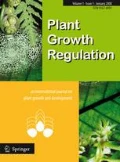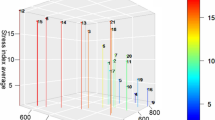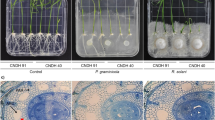Abstract
To explore the molecular mechanism of allelopathic rice in response to low nitrogen (N) supply or accompanying weed stress, allelopathic rice PI 312777 and its counterpart Lemont were grown under low N supply or co-cultured with barnyardgrass [Echinochloa crus-galli (L.) Beauv.] in hydroponics. The suppression subtractive hybridization (SSH) technique was employed to isolate the up-regulated genes in the treated rice accession. The results indicated that the expression of the genes associated with N utilization was significantly up-regulated in allelopathic rice PI 312777, and the higher efficiency of N uptake and its utilization were also detected in PI 312777 than that in Lemont when the two rice accessions were exposed to low N supply. This result suggested that the allelopathic rice had higher ability to adapt to low N stress than its non-allelopathic counterpart. However, a different response was observed when the allelopathic rice was exposed to accompanying weed (barnyardgrass) co-cultured in full Hoagland solution (normal N supply). It showed that the expression of the genes associated with allelochemical synthesis and its detoxification were all up-regulated in the allelopathic rice when co-cultured with the target weed under normal N supply. The results suggested that the allelopathic rice should be a better competitor in the rice-weed co-culture system, which could be attributed to increasing de novo biosynthesis and detoxification of allelochemicals in rice, consequently resulting in enhanced allelopathic effect on the target and preventing the autotoxicity in this process. These findings suggested that the accompanying weed, barnyardgrass is not only the stressful factor, but also one of the triggers in activating allelopathy in rice. This implies that the allelopathic rice is sensible of the existing target in chemical communication.



Similar content being viewed by others
Abbreviations
- AOC:
-
Allene oxide cyclase
- 4CL:
-
4-coumarate-CoA ligase
- ER:
-
Endoplasmic reticulum
- GDH:
-
Glutamate dehydrogenase
- GST:
-
Glutathione S-transferase
- JA:
-
Jasmonic acid
- MT:
-
Metallothionein-like protein
- MYB:
-
V-myb avian myeloblastosis viral oncogene homolog
- N:
-
Nitrogen
- NUE:
-
Nitrogen use efficiency
- P450s:
-
Cytochrome P450 monooxygenase
- PAL:
-
Phenylalanine ammonia-lyase
- SSH:
-
Suppression subtractive hybridization
- TRAP:
-
Translocon-associated protein complex
References
Anterola AM, Jeon JH, Davin LB, Lewis NG (2002) Transcriptional control of monolignol biosynthesis in Pinus taeda: factors affecting monolignol ratios and carbon allocation in phenylpropanoid metabolism. J Biol Chem 277:18272–18280
Belz RG (2007) Allelopathy in crop/weed interactions—an update. Pest Manag Sci 63:308–326
Belz RG, Hurle K (2004) A novel laboratory screening bioassay for crop seedling allelopathy. J Chem Ecol 30:175–198
Bi HH, Zeng RS, Su LM, An M, Luo SM (2007) Rice allelopathy induced by methyl jasmonate and methyl salicylate. J Chem Ecol 33:1089–1103
Bole-Feysot C, Perret E, Roustan P, Bouchard B, Kelly PA (2000) Analysis of prolactin-modulated gene expression profiles during the Nb2 cell cycle using differential screening techniques. Genome Biol 1: research0008.1–0008.15
Chaopongpang S, Pornpattkul C, Pitaksutheepong J, Limpananont PC, Boonjawat J (1992) The role of lectin in association between rice and nitrogen-fixing bacteria. In: Mongkolsuk S, Lovett PS, Trempy JE (eds) Biotechnology and environmental science: molecular approaches. Plenum Press, New York, pp 81–88
Chen MJ, Ni M (2006) RFI2, a RING-domain zinc finger protein, negatively regulates CONSTANS expression and photoperiodic flowering. Plant J 46:823–833
Dalisay RF, Kuc JA (1995) Persistence of induced resistance and enhanced peroxidase and chitinase activities in cucumber plants. Physiol Plant Pathol 47:315–327
Diatchenko L, Lau YFC, Campbell AP, Chenchik A, Moqadam F, Huang B, Lukyanov S, Lukyanov K, Gurskaya N, Sverdlov ED, Siebert PD (1996) Suppression subtractive hybridization: a method for generating differentially regulated or tissue-specific cDNA probes and libraries. Proc Natl Acad Sci USA 93:6025–6030
Duguin JL, Dinauer MC (1990) Library subtraction of in vitro cDNA libraries to identify differentially expressed genes in scrapie infection. Nucleic Acids Res 18:2789–2792
Edreva A (2005) Pathogenesis-related proteins: research progress in the last 15 years. Gen Appl Plant Physiol 31:105–124
Einhellig FA (1999) An integrated view of allelochemicals amid multiple stresses. In: Inderjit, Dakshin KMM, Foy CL (eds) Principles and practices in plant ecology: allelochemical interactions. CRC Press, Boca Raton, pp 479–494
Errebhi M, Rosen CJ, Lauer FI, Martin MW, Bamberg JB (1999) Evaluation of tuber-bearing Solanum species for nitrogen use efficiency and biomass partitioning. Am J Potato Res 76:143–151
Fajer ED, Bowers MD, Bazzaz FA (1992) The effect of nutrients and enriched CO2 environments on production of carbon-based allelochemicals in plantago: a test of the carbon/nutrient balance. Am Nat 140:702–723
Fang CX, Wu XC, Zhang HL, Xiong J, Wu WX, Lin WX (2009a) UV-induced differential gene expression in rice cultivars analyzed by SSH. Plant Growth Regul 59:245–253
Fang CX, Xiong J, Qiu L, Wang HB, Song BQ, He HB, Lin RY, Lin WX (2009b) Analysis of gene expressions associated with increased allelopathy in rice (Oryza sativa L.) induced by exogenous salicylic acid. Plant Growth Regul 57:163–172
Grace JB, Tilman D (1990) Perspectives on plant competition. Academic Press, San Diego
Gross GG, Zenk MH (1974) Isolation and properties of hydroxycinnamate: CoA ligase from lignifying tissue of Forsythia. Eur J Biochem 42:453–459
Guterman A, Hajouj T, Gepstein S (2003) Senescence-associated mRNAs that may participate in signal transduction and protein trafficking. Physiol Plant 118:439–446
Hammerschmidt R, Nuckles EM, Kuc J (1982) Association of enhanced peroxidase activity with induced systemic resistance of cucumber to Collectotrchum lagenarium. Physiol Mol Plant Pathol 20:73–82
Harper JL (1977) Population biology of plants. Academic Press, New York
He HB (2009) Change in allelopathic potential of rice and its molecular mechanism in the responses to barnyardgrass stress. Dissertation, Fujian Agriculture and Forestry University, Fuzhou
Kang JY, Choi HI, Im MY, Kim SY (2002) Arabidopsis basic leucine zipper proteins that mediate stress-responsive abscisic acid signaling. Plant Cell 14:343–357
Khanh TD, Chung IM, Tawata S, Xuan TD (2007) Allelopathy for weed management in sustainable agriculture. CAB Rev, CABI. http://www.cabi.org/cabreviews/default.aspx. Accessed 16 May 2007
Kim KU, Shin DH (2008) Progress and prospect of rice allelopathy research. In: Zeng RS, Mallik AU, Luo SM (eds) Allelopathy in sustainable agriculture and forestry. Springer, New York, pp 189–233
Kim SY, Madrid AV, Park ST, Yang SJ, Olofsdotter M (2005) Evaluation of rice allelopathy in hydroponics. Weed Res 45:74–79
Kizil G, Wilks K, Wells D, AlàAldeen DA (2000) Detection and characterisation of the genes encoding glyoxalase I and II from Neisseria meningitidis. J Med Microbiol 49:669–673
Landschulz WH, Johnson PF, McKnight SL (1988) The leucine zipper: a hypothetical structure common to a new class of DNA-binding proteins. Science 240:1759–1764
Leung J, Merlot S, Giraudat J (1997) The Arabidopsis abscisic acid-insensitive 2 (ABI2) and ABI1 genes encode homologous protein phosphatases 2C involved in abscisic acid signal transduction. Plant Cell 9:759–771
Liang P, Pardee AB (1992) Differential display of eukaryotic messenger RNA by means of the polymerase chain reaction. Science 257:967–971
Maiti MK, Krishnasamy S, Owen HA, Makaroff CA (1997) Molecular characterization of glyoxalase II from Arabidopsis thaliana. Plant Mol Biol 35:471–481
Mallik A (2005) Allelopathy: advances, challenges and opportunities. Fourth world congress on allelopathy. The Regional Institute Limited publishing. http://www.regional.org.au/au/allelopathy. Accessed 21 Aug 2005
Manning G, Plowman GD, Hunter T, Sudarsanam S (2002) Evolution of protein kinase signaling from yeast to man. Trends Biochem Sci 27:514–520
Mesbah K, Camus A, Babinet C, Barra J (2006) Mutation in the Trap/Ssr1 gene, encoding translocon-associated protein, results in outflow tract morphogenetic defects. Mol Cell Biol 26:7760–7771
Moll RH, Kamprath EJ, Jackson WA (1982) Analysis and interpretation of factors which contribute to efficiency of nitrogen utilization. Agron J 74:562–564
Morris DL (1948) Quantitative determination of carbohydrate with dreywoods anthrone reagent. Science 107:254–255
Ni HW, Zhang CX (2005) Use of allelopathy for weed management in China—a review. Allelopath J 15:3–12
Nkonge C, Ballance GM (1982) A sensitive colorimetric procedure for nitrogen determination in micro-Kjeldahl digests. J Agric Food Chem 30:416–420
Peng JY, Li ZH, Huang YP (2007) Plant species specific defense signal communication differentially regulates glutathione S-transferase activity and gene expression in the Helicoverpa armigera (Hubner). J Plant Interact 2:93–99
Rice EL (1984) Allelopathy, 2nd edn. Academic Press, New York
Rice EL (1995) Biological control of weeds and plant diseases. University of Oklahoma Press, Norman
Robert C, Gagné D, Bousquet D, Barnes FL, Sirard M (2001) Differential display and suppressive subtractive hybridization used to identify granulosa cell messenger RNA associated with bovine oocyte developmental competence. Biol Reprod 64:1812–1820
Robinson SA, Slade AP, Fox GG, Phillips R, Ratcliffe RG, Stewart GR (1991) The role of glutamate dehydrogenase in plant nitrogen metabolism. Plant Physiol 95:509–516
Sano H, Ohashi Y (1995) Involvement of small GTP-binding proteins in defense signal-transduction pathways of higher plants. Proc Natl Acad Sci USA 92:4138–4144
Shen LH, Lin WX (2007) Effects of phosphorus levels on allelopathic potential of rice co-cultured with barnyardgrass. Allelopath J 19:393–402
Song BQ, Xiong J, Fang CX, Qiu L, Lin RY, Liang YY, Lin WX (2008) Allelopathic enhancement and differential gene expression in rice under low nitrogen treatment. J Chem Ecol 34:688–695
Stenzel I, Hause B, Miersch O, Kramell R, Kurz T, Maucher H, Weichert H, Ziegler J, Feussner I, Wasternack C (2003) Jasmonate biosynthesis and the allene oxide cyclase family of Arabidopsis thaliana. Plant Mol Biol 51:895–911
Stillman TJ, Baker PJ, Britton KL, Rice DW (1993) Conformational flexibility in glutamate dehydrogenase role of water in substrate recognition and catalysis. J Mol Biol 234:1131–1139
Stone JM, Walker JC (1995) Plant protein kinase families and signal transduction. Plant Physiol 108:451–457
Sun YJ, Zhou XF, Ma H (2007) Genome-wide analysis of Kelch repeat-containing F-box family. J Integr Plant Biol 49:940–952
Turnbull JJ, Nakajima J, Welford RW, Yamazaki M, Saito K, Schofield CJ (2004) Mechanistic studies on three 2-oxoglutarate-dependent oxygenases of flavonoid biosynthesis: anthocyanidin synthase, flavonol synthase, and flavanone 3β-hydroxylase. J Biol Chem 279:1206–1216
Uhlman A, Ebel J (1993) Molecular cloning and expression of 4-coumarate: coenzyme A ligase, an enzyme involved in the resistance response of soybean (Glycine max L.) against pathogen attack. Plant Physiol 102:1147–1156
Wang HB, He HB, Chen CY, Lu JC, Chen RS, Guo XK, Liu CH, Lin WX (2009) Physiological responses of allelopathic rice accessions to low phosphorus stress. Allelopath J 23:175–184
Wu H, Pratley J, Lemerle D, Haig T (1999) Crop cultivars with allelopathic capability. Weed Res 39:171–180
Xiong J, Lin WX, Zhou JJ, Wu MH, Chen XX, He HQ (2005) Studies on biointerference between barnyardgrass and rice accessions at different nitrogen regimes. Fourth world congress on allelopathy. The Regional Institute Limited publishing. http://www.regional.org.au/au/allelopathy. Accessed 21 Aug 2005
Yamamoto T, Mori Y, Ishibashi T, Uchiyama Y, Sakaguchi N, Furukawa T, Hashimoto J, Kimura S, Sakaguchi K (2004) Characterization of Rad6 from a higher plant, rice (Oryza sativa L.) and its interaction with Sgt1, a subunit of the SCF ubiquitin ligase complex. Biochem Biophys Res Commun 314:434–439
Ziegler J, Stenzel I, Hause B, Maucher H, Hamberg M, Grimm R, Ganal M, Wasternack C (2000) Molecular cloning of allene oxide cyclase. The enzyme establishing the stereochemistry of octadecanoids and jasmonates. J Biol Chem 275:19132–19138
Acknowledgments
This work was supported by the National Natural Science Foundation of China (No. 30471028) and Provincial Natural Science Foundation of Fujian, China (No. 2009J05045). The authors thank Dr. C.C. Chen for his critical reading of the manuscript.
Author information
Authors and Affiliations
Corresponding author
Additional information
Chang-Xun Fang and Hai-Bin He have contributed equally to this work.
Rights and permissions
About this article
Cite this article
Fang, CX., He, HB., Wang, QS. et al. Genomic analysis of allelopathic response to low nitrogen and barnyardgrass competition in rice (Oryza sativa L.). Plant Growth Regul 61, 277–286 (2010). https://doi.org/10.1007/s10725-010-9475-8
Received:
Accepted:
Published:
Issue Date:
DOI: https://doi.org/10.1007/s10725-010-9475-8




